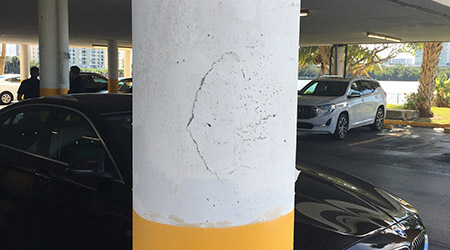Understanding Concrete Cracks: A Primer
Property managers must pro-actively be on the lookout for concrete cracking and spalling.
Property management professionals know that their jobs are no joke. One of the most critical responsibilities of any property manager is the continuing observation and awareness of the physical condition of the building they manage. Because more buildings are constructed using concrete than any other construction material, it is important for property managers to understand what concrete is, how it is used, the potential problems with concrete and how to correct them.
Concrete is a word whose root is Latin for “compact” or “condensed.” The word is apt, because concrete can bear substantial weight, so its use has facilitated construction of buildings of multiple floors in height, with weight of upper floors strongly supported by concrete below. Unlike stone, concrete can be placed and formed to desired configurations and its basic components are typically locally available, or at least more easily transported. In contrast, stone must be carved and cut to desired shapes, and may not be locally available and therefore would have to be transported great distances at tremendous effort (think of the Egyptian pyramids or Peruvian Inca temples).
The terms “concrete” and “cement” are sometimes incorrectly used interchangeably, but they are not the same thing. Cement is a component of concrete, along with an aggregate (sand, gravel or rocks), water and sometimes other additives. The cement binds the aggregate together in a paste, which hardens to a stone-like material as the water dissipates out of the mixture. It is the mix of components that provides concrete with the strength and durability, which have made it a principal building material around the world for thousands of years.
But not all concrete is the same. By varying proportions of the aggregate, cement and water, concrete strength and density can be controlled in a predictable process. In current uses, “normal” strength concretes ranging from 1,450 PSI to 5,800 PSI may be used for sidewalks, curbs, building columns, beams and floor slabs and many other typical construction purposes, while high-strength concretes exceeding 6,000 PSI, lightweight concretes, extra-dense concretes, polymer-modified concretes and mixes using specialty aggregates, fillers and admixtures are specified and used for highways and bridges, warehouse floors, under-water structures, repairs and other specialized applications.
Generally, a greater proportion of cement in a concrete mix will make the concrete stronger, but cement is the most expensive component of normal concretes. Therefore, engineers who design structures must balance the goals of sufficient concrete strength and cost efficiency. While it might be technically possible to make all concrete used in every purpose super-hard and super-strong, the cost of doing so might prevent many buildings and other structures from ever being constructed. Properly designed and constructed concrete structures that are adequately maintained should provide building lifespans of decades or generations.
What causes cracks?
Although concrete is rock-hard, heavy and stable, it is not inert. As soon as it is placed, concrete begins to change its physical properties as the water in its mix dissipates out of it through a process called hydration. If the concrete hydrates too quickly, cracks may occur in the concrete surface. Even if no cracking occurs as a result of initial hydration, concrete reacts to changes in temperature and changes in humidity, expanding and contracting as the weather where the building is located changes. Those thermal movements may likewise result in cracks in the concrete. It is normal and typical for cracks to occur on the surface of concrete. In fact, in some constructions, engineers design “control joints” into the structure to cause the cracking they know will occur to happen in a pre-selected location rather than randomly.
Very different from hydration cracks and thermal movement cracks, structural cracks can also occur when concrete is exposed to weight or force that exceeds its capacity (overloading, impact, explosions) or to movement beyond its design capability (building settling, earthquake, hurricane or tornado, vibrations), causing the concrete to break.
The fact that a crack or cracks exist in a concrete structure absolutely warrants a property manager’s attention, but does not necessarily signal an imminent emergency. Nearly all cracks in concrete are bad, but for different reasons. Structural cracks are of great concern, because the beam, column or floor slab in which the crack has occurred is compromised and no longer provides the same level of strength and support to the surrounding building components. Aesthetic surface cracks may not pose such immediate structural concern, but the consequences to which they can lead can be just as grave.
Typical concrete construction includes reinforcing steel embedded within the concrete to add tensile strength to the structure. Cracks in the concrete surface allow moisture from rain, fog or even humidity to penetrate below the surface of the concrete to reach the embedded steel, causing it to rust. As steel rusts, the rust expands, exerting outward pressure on the concrete encasing it. The pressure of the expanding rust pushes the cracks open further, allowing more water down to the rebar and accelerating the rusting process.
Eventually, the combination of increased cracking and outward pressure breaks pieces of the concrete apart from the rest of the structure. Such concrete “spalling” poses immediate danger of a piece or chunk of concrete falling on a person or object below it. The separation of a piece of a beam, column, wall or floor slab weakens the entire assembly, and the corrosion of the reinforcing steel further weakens the assembly. The process of concrete cracks leading to rusting rebar causing concrete spalling can occur in months or it may take years; but once the process starts, the condition typically worsens in an accelerating timeline.
Inspections and repairs
It is therefore important that property managers pro-actively be on the lookout for concrete cracking and spalling. Routine periodic inspection of accessible concrete structural components should be performed at fixed intervals, with further inspections between scheduled examinations if problems present themselves. Photo documentation of all observable concrete elements should be taken at the same locations at each inspection, to establish a basis for checking any changes of condition.
Because of building heights and configurations, it may be difficult or impossible for a property manager to observe and document building structural conditions in some parts of their property. In such cases, a structural engineer who specializes in forensic investigation of existing structures may be contracted to perform investigation of difficult-to-reach locations. The engineer may in turn need to engage a specialty building repair contractor to place and operate swing stages, manlifts, to erect scaffold or otherwise to provide access to allow the engineer’s evaluation.
Because of the expense of such building exterior inspections, they should be planned for and budgeted on a reasonable, periodic basis. Some jurisdictions around the country may already have in place time frames for performance of building structural inspections and, in the aftermath of the tragic building collapse in Surfside, Florida, more jurisdictions are considering and mandating such inspection obligations. Property managers should be guided by local requirements at a minimum, but should incorporate routine visual inspection themselves or by their staff as frequently as monthly and in no case less than annually.
In the best case, concrete cracking and resulting problems can be largely eliminated before they ever occur. Proper specification of materials, quality control during construction and application and maintenance of quality paints and waterproofing over concrete exposed to the elements will go a long way to preventing concrete cracking and resulting structural degradation.
But most often, property managers have little or no involvement in design or construction of the buildings they manage. The challenge then is to identify and mitigate problem conditions that may already exist, and to then manage those risks moving forward. If property management staff observes cracks or spalls in concrete columns or beams, floor slabs or other structural elements, a forensic structural engineer should be consulted to evaluate the conditions, even if between any mandated inspection periods. The engineer can help property managers and building owners understand the level of severity of any cracks or spalls, and evaluate the need for repair and cost to do so.
Most typical concrete cracks and spalls can be repaired to a condition which restores a building’s safe use and operation. The International Concrete Repair Institute (ICRI), an organization of design professionals, contractors and material manufacturers specializing in concrete repair and restoration, has published a variety of guidelines for proper treatment of compromised or failed concrete conditions, including: cleaning and patching of spalled concrete; epoxy adhesive of cracked concrete; structural reinforcing of weakened or repurposed concrete using carbon fiber or other supplementary reinforcing methods; and proper preparation and application of waterproofing materials.
Many waterproofing materials have highly flexible characteristics. As the surfaces on which they are applied expand and contract in response to daily and seasonal temperature changes, the coatings remain intact and prevent water intrusion into any hairline cracks which may continue to occur. Waterproofing coatings are typically subject to UV degradation, weathering from rain, salt air and wear from pedestrian or vehicle use, so periodic recoating or replacement of waterproofing should be planned to extend the life of structural concrete. Such preventative maintenance will minimize need for concrete repairs.
Buildings are like living creatures, and concrete structures are like the skeletons of those creatures, providing strength and support for all the building’s purposes. Like the health of a body, the health of a building’s concrete structure can be maintained by following good practices of observation, prevention and timely action to repair when needed.
Brian Daley, Branch Manager of C.A. Lindman of South Florida, LLC, is also a past-president of the International Concrete Repair Institute (2017). ICRI is an association of concrete repair and restoration professionals and is a resource for education and information to improve the quality of repair, restoration, and protection of concrete and other structures in accordance with consensus data. In the aftermath of the Surfside tragedy, ICRI has assembled a catalogue of free, online resources that can aid property managers in their evaluations.
Related Topics:












